Uncategorized
Today Only – Fill These Stacks With Funds, Not Fumes
 Good Morning. It's North Texas "Giving Day."
Good Morning. It's North Texas "Giving Day."
From 6 am to 12 Midlnight tonight, online donations of $25 or more to Downwinders at Risk get multiplied or matched by the Communities Foundation of Texas.
This year we're asking your help in supporting our first ever annual grassroots citizen activist conference, the Root and Branch Revue.
Not only will this conference offer DFW residents the chance to hang out, talk with, and learn from legendary environmetnal icon Lois Gibbs. You'll also meet and learn from her husband, harvard-trained toxicologist, Dr. Stephen Lester. This is the first time these two have teamed up to come to Texas and do citizen training.
Just as important are the peer-to-peer discussions and brainstorming sponsored by the conference. Not only will we host a two-hour panel discussion on the future of fighting fracking in Texas at our kick-off on Thursday, November 5th, but we'll folow that up with a second two-hour follow-up session on fracking strategy as part of our full day of workshops on Saturday, November 7th. In between, we'll be staging a "Get Tough with Texas" rally at EPA HQ in downtown Dallas that will spotlight why the feds need to crack down on Austin's "nullification" of evironmental laws and policy.
Downwinders fights for your lungs 365 days a year. Today, we need you to fight for us. Thanks very much for your consideration. Donate here.
A Major Announcement from Downwinders at Risk
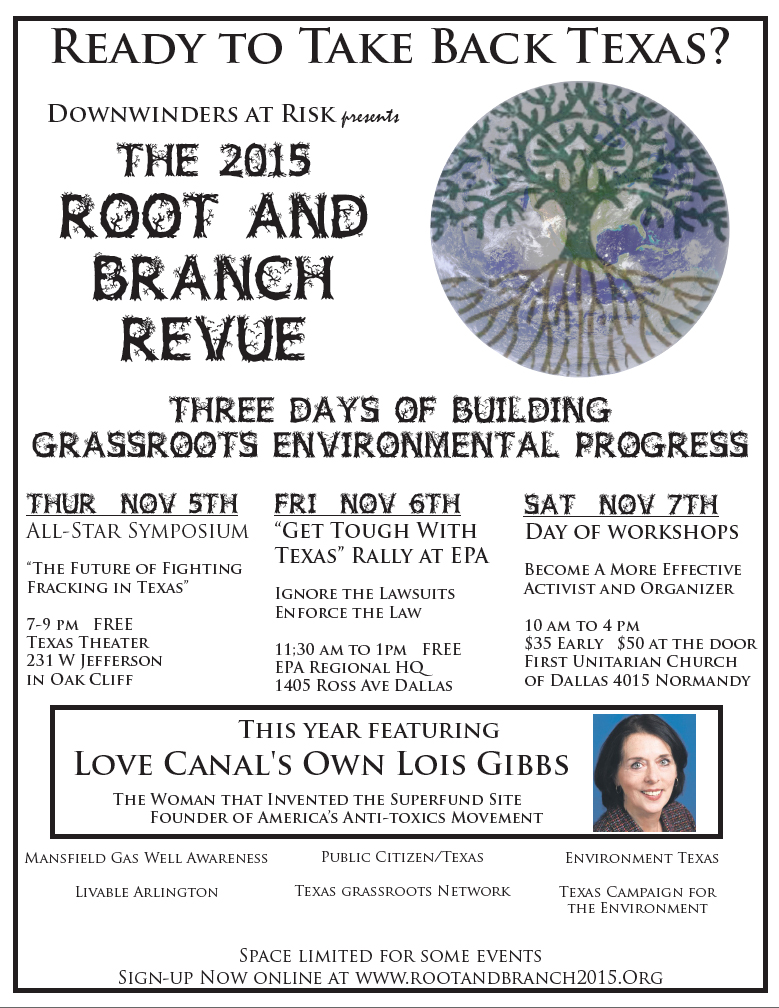
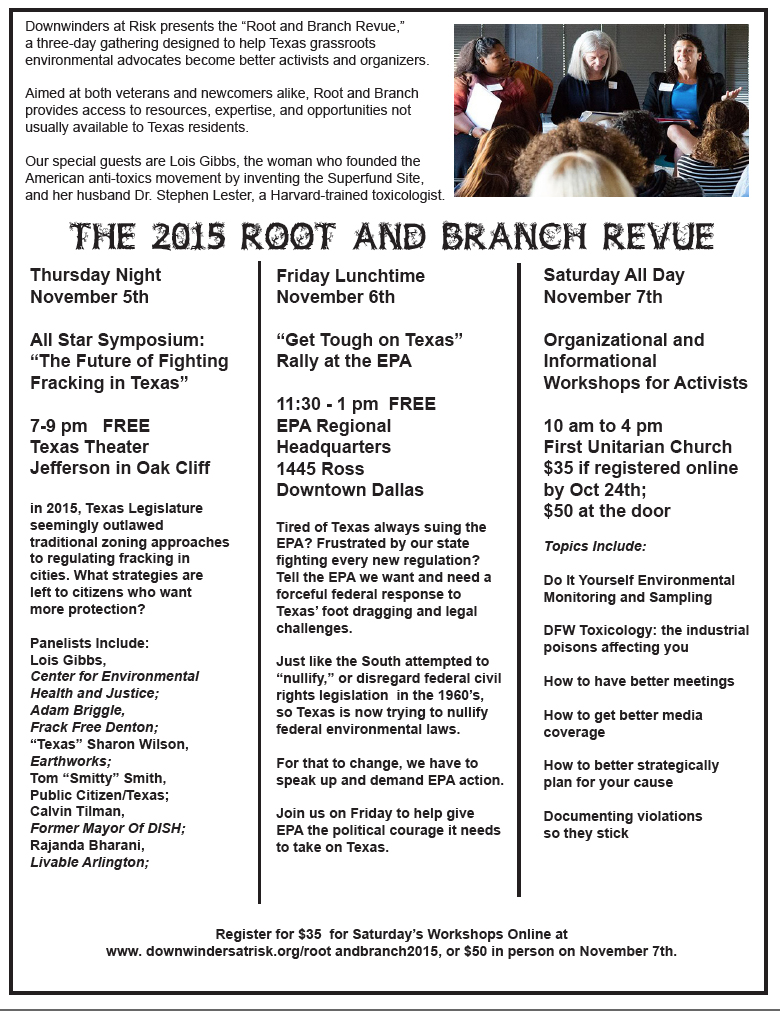
Group Announces Texas Grassroots Conference in November; Billed as
“The SXSW for Environmental Activists”
Love Canal’s Own Lois Gibbs Will Be Featured Guest At the First Annual “Root and Branch Revue”
(Dallas) — Saying their intent is to build a stronger grassroots environmental movement across Texas that can stop the state’s nullification of federal environmental laws and the rollback of rights to oppose large polluters, leaders of the local clean air group Downwinders at Risk announced an ambitious three-day conference in November aimed at honing the skills of Texas' citizen-activists.
Called “The Root and Branch Revue,” the event will feature Love Canal's Lois Gibbs, sometimes referred to as "the Rosa Parks of the Environmental Movement," and kick-off with a panel discussion on “The Future of Fighting Fracking in Texas” that will examine what tools citizens have in a post HB-40 world. Passed by the state legislature this last spring, HB 40 was the controversial bill prohibiting municipalities from using traditional zoning to regulate the location and operation of oil an gas facilities.
Scheduled for Thursday, November 5th through Saturday the 7th, the Revue is actually a rolling collection of events that includes the panel discussion, a lunchtime “Get Tough on Texas” rally at EPA regional headquarters in downtown Dallas, and a full day of workshops that will pass along tips on how to do your own air sampling and monitoring, get better media coverage for your cause, have more effective meetings .
Planners are also talking with the Dallas-based "hyper-local" Bar Politics comedy troupe for a environmentally-themed show as part of the festivities. This is not your typical environmental conference.
"We're billing it as the South by Southwest for activists," said Downwinders' board member and conference coordinator Tamera Bounds. "We want to offer a lot of different experiences – training from experts, brainstorming and socializing with your peers, and a chance to rally at EPA's regional headquarters with everyone else getting the shaft from Austin."
Bounds said Downwinders hopes to make the Revue an annual affair and wanted to kick off the tradition by inviting the original "hysterical housewife" who founded America's anti-toxics movement. “Downwinders and every other group like us can trace our origins back to Lois Gibbs' fight at Love Canal. She’s the mother of us all, and for our first year we wanted to honor that history."
Gibbs’s involvement in environmental causes began in 1978 when she discovered that her 7-year-old son’s elementary school in Niagara Falls, New York was built on a toxic waste dump containing over 20,000 tons of poisons, including Dioxin. Investigation revealed that her entire neighborhood, Love Canal, had been built on top of this dump. With no prior experience in community activism, Gibbs organized her neighbors and led her community in a battle against the local, state, and federal governments. After years of struggle, 833 families were eventually evacuated, and cleanup of Love Canal began. National press coverage made Lois Gibbs a household name and her efforts led to the creation of the U.S. Environmental Protection Agency’s “Superfund,” toxic waste clean-up fund.
In 1980, Gibbs formed the Citizens’ Clearinghouse for Hazardous Waste, later renamed the Center for Health, Environment and Justice (CHEJ), where she currently serves as Executive Director. CHEJ is a grassroots environmental crisis center that provides information, resources, technical assistance and training to community groups around the nation. It will be the first time Gibbs will be coming to train citizens in Texas. She'll be joined by her husband, Harvard-trained toxicologist Stephen Lester, who serves as Science Director for the Center.
All but a few events of the conference will be free. Saturday's day of workshops costs $35 if you register early, $50 if you don't. And that includes lunch.
You can find out more details, and sign-up for the day of workshops at the conference website:
First Year Result of State’s New Clean Air Plan? DFW Smog Gets Worse
 Yesterday's smog wasn't the worst DFW has seen in 2015, but it was bad enough to make sure the first year of the State's proposed clean air plan for the area concludes with worse smog than when it started. Denton's running smog average inched up from 81 parts per billion in 2014 to 82 ppb at about 9 pm last night, with a month of hardcore ozone season left.
Yesterday's smog wasn't the worst DFW has seen in 2015, but it was bad enough to make sure the first year of the State's proposed clean air plan for the area concludes with worse smog than when it started. Denton's running smog average inched up from 81 parts per billion in 2014 to 82 ppb at about 9 pm last night, with a month of hardcore ozone season left.
This is the second time DFW's smog average has increased in the last four years. The last time it happened was in the middle of implementing a state clean air plan that imposed no new controls on any large polluters. This time it happened just as another such plan was being submitted to EPA for approval.
There has been a lot of crowing from Austin and industry about how much DFW ozone levels decreased last year. But most of that was weather-related. It was unusually wet and cool. As a result, in 2014, there were only two (out of 20 ) DFW monitors that had official ozone violations of 75 ppb or above. This year, and especially this August, has been a bit more normal. There are already nine monitors that have registered violations of 75 or above.
Moreover, DFW's running three-year smog average, or what the EPA calls the Design Value, is the worst in the state now, surpassing Houston despite both metro areas having bad ozone seasons this year. As of today, its 82 ppb average means Denton holds the dubious honor of hosting the ozone monitor with the state's highest Design Value. The second worst is the Ft. Worth Nortwestern (Meachum Field) monitor, tied with a monitor in Houston. These facts lend credence to clean air advocates' claims that last year's low smog levels were an anomoly and not the beginning of a new trend.
Thanks to a federal court case back in December, the official deadline for meeting or exceeding the current 75 parts per billion ozone standard at all 20 DFW monitors is now 2017, instead of 2018. That means this year's bad numbers will be used with those in 2016 and 2017 in averaging a new Design Value and declaring the success or failure of the state's clean air plan by September of 2017.
Because of the last three or four weeks of bad air, the gap between where we are (82ppb) and that 75 ppb goal is wider. As of now, the next two summers have to be as cool and wet as 2014 to even have a chance of decreasing ozone by the 7 ppb or more needed to get down to the legal limit.
And – of course that legal limit is going to be revised in October when EPA decides what the new national ozone standard will be, probably somewhere between 65 and 70 ppb.
So….let's review. Air quality in DFW is worse this year than last. We're starting from further behind than we were at the beginning of summer. The state has turned in a new clean air plan to EPA that once again doesn't require any new controls on any major polluters – kilns, coal plants or natural gas, even though we need deep decreases in smog pollution to get safe and legal air by the new federal deadline.
That's why we need the EPA to take the job of drafting a new clean air plan out of the hands of a state agency unwilling to enforce the law and do it themselves via a Federal Implementation Plan, or FIP. Until the grown-ups are in charge, DFW will never see a clean air deadline met.
The State’s “Do-Nothing” DFW Air Plan is Falling Apart. Here’s Our Chance to Have a Real One.
 For the second time in five years, the Texas Commission on Environmental Quality thought it had gamed the system. It believed it could get away with another DFW "clean air plan" that didn't actually do anything. It looks like it was wrong.
For the second time in five years, the Texas Commission on Environmental Quality thought it had gamed the system. It believed it could get away with another DFW "clean air plan" that didn't actually do anything. It looks like it was wrong.
A series of events playing out since December of last year has seemingly laid waste to the state's intent to get approval from EPA for its "State Implementation Plan" (SIP) for DFW smog that didn't touch the major sources of air pollution in North Texas. As a result, citizens have an opportunity for the first time since 2011 to get a real clean air plan – but only if we organize and focus on demanding EPA do its job.
Stick with us here. It's kind of a long trip, full of regulatory jargon and jousting, but the destination is worth it.
Because of what seems like an intractable disagreement between the state and EPA over the content of the state's proposed 2015 air plan for DFW, citizens have a chance to press for the real thing – a federal plan, drafted and implemented by EPA – that could finally bring deep cuts to major sources of pollution like the Midlothian cement kilns, East Texas Coal Plants, and the oil and gas industry.
If that sounds like an attractive option to you, there are two things you can do right now to make it more likely:
1) Sign the petition for a Federal Plan at Change.org
In the last six months the fate of the state's plan has been radically altered. Among the most dramatic changes:
1) Only days before Christmas, a federal court ruling pushed back the deadline for DFW to meet the current 75 parts per billion ozone/smog standard from 2018 to 2017. Despite knowing about the court decision, until very recently the state kept aiming its plan at 2018. It hadn't made changes to its computer modeling to adjust to a 2017 goal. Now there's a real question as to whether it can submit all the data EPA requires by a July 20th deadline to turn it in for review. If the state doesn't get all the information in, EPA must rule that the plan is "incomplete." As of right now, a month before it's due, that's the conclusion EPA would have to reach.
2) Official EPA comments on the state's plan are highly critical of it, echoing many of the same assessments raised by citizens in the January Arlington City Hall hearing, and written comments submitted by Downwinders and the Sierra Club. For example,
– The inadequacy of the state's plan and need for more pollution reductions: "…it is difficult to see how the area would reach attainment in 2018….The fact that the attainment year will likely be 2017 makes the chance of attainment smaller…The recent court decision…makes it less clear that the area will attain the standard by 2017 without additional reductions…we believe it is likely that additional reductions will need to be included to demonstrate attainment.”
– The quality of the state's computer modeling, which drives the entire plan: "The monitor data does not show the large drops in local ozone levels and therefore raises a fundamental question whether the photochemical modeling is working as an accurate tool for assessing attainment in 2018 for DFW”….the episode overall is not fully representative of the most difficult ozone scenarios. In addition, while current ozone trends and the model predictions support that ozone levels will continue to improve, it is not clear to EPA that these trends are sufficient for the area to attain by 2018.”
– More cuts are needed from the Midlothian cement kilns: "…the TCEQ estimates that reducing the source cap for the kilns in Ellis County would not provide significant emission reductions for the DFW area. However, a reduction in the source cap…does appear significant...TCEQ’s rules need to be reevaluated to insure…the emission limits reflect a Reasonably Available Control Technology (RACT) level of control as required by the Clean Air Act….We can no longer conclude the emission limit that is in place reflects a RACT level of control…Failure to conduct a thorough RACT analysis for cement kilns which would include appropriate emission limits would prevent us from approving the RACT portion of the attainment plan submittal.”
– More cuts are needed from the East Texas coal plants: “The TCEQ provided an evaluation of emissions from all of the utility electric generators in east and central Texas. However, the discussion in Appendix D on the formation, background levels, and transport of ozone strongly supports the implementation of controls on NOx sources located to the east and southeast of the DFW nonattainment area."
What is that discussion in TCEQ's Appendix D? It's this incriminating admission: "…efforts focused solely on controlling local emissions may be insufficient to bring the DFW area into ozone attainment …."
– Link between oil and gas sources and higher ozone levels: "These monitors (Eagle Mtn. Lake, Denton, and Parker County) are in areas more impacted by the growth in NOx sources for Oil and Gas Development that seem to be countering the normal reduction in NOx levels seen at other monitors…."
"We have some concern that as well pressure diminishes that natural gas fired engines driving natural gas compressors may be utilized more than the current usage per production amount. This may result in the projected NOx emissions not dropping as much as projected. The same volume of gas being produced with less well head pressure flow could need more overall actual compression to get to market. This situation could result in more NOx emissions than estimated based on the current emissions/production level relationship."
3) EPA requests for information from TCEQ leave no doubt that EPA wants more pollution cuts in the plan and that without those cuts, the plan is in deep trouble. Examples:
– “Please provide the estimated amount of emission reductions (in tons per day) that would reduce ozone values at the monitors by 1 ppb…please include the estimated emissions reductions associated with each of the (control) measures."
– “An evaluation…for cement kilns in Ellis County is needed that reflects the level of control that can reasonably be achieved and new limits to reflect the reasonable level of control.”
– “How would a reduction in emissions from utility electric generators in just the counties closest to the eastern and southern boundaries of the DFW area impact the DFW area?”
– “The updated modeling results provided in early January by TCEQ indicate one monitor at 76 ppb in 2018 using the new DRAFT guidance and existing guidance methods indicate 77 ppb at Denton and 76 ppb at Eagle Mtn. Lake and Grapevine. We note that these numbers will most likely go up some with an attainment demonstration based on 2017. We request that TCEQ supplement their analysis as needed to show that the area will attain by 2017.”
All of those EPA comments and requests were made way back in early February. The state only got around to responding to them on June 3rd. With the July 20th deadline for final submission of a DFW air plan to EPA rapidly approaching, this is TCEQ's June 3rd answer:
"It was not possible to complete all work necessary for this DFW Attainment Demonstration SIP revision to demonstrate attainment in 2017. The DFW AD SIP revision also commits to develop a new Attainment Demonstration SIP revision for the DFW 2008 eight-hour ozone non-attainment area as long as 2017 remains the attainment year. The new DFW Attainment Demonstration SIP revision would include the following analyses to reflect the 2017 attainment year: a modeled Attainment Demonstration, a reasonably available control measures (RACM) analysis….."
Rhetorically, TCEQ seems to be committing to submitting a new plan or parts of a new plan to EPA by July 20th, but it's very unclear how much, if any a "new" TCEQ DFW air plan will differ from the current one. The modeling for 2018 took Austin over a year to finish and there are serious doubts about whether the state can condense that process into less than two months to churn out entirely new results for 2017.
Moreover, the state knows what it will find if it does accomplish that feat: higher ozone levels.
At its most basic, the TCEQ plan for 2018 attainment with the 75 parts per billion standard relied exclusively on federal changes in the chemical make-up of gasoline that will reduce its sulfur content, due to hit the marketplace in January 2017. Before the December court ruling, that meant a whole two summers for that fuel change to reduce the pollution from cars without the state lifting a finger to cut pollution from industrial sources like the cement kilns, coal plants, or gas industry.
Now, however, with the attainment date moved up by a year, it means only one year of impact from that fuel change. It means that instead of averaging the 4th highest ozone readings from 2016, 2017, and 2018 for the required rolling three- year average that determines success or failure, it will be this year, 2016 and 2017. Two out those three years will not see the benefit of that federal fuel change on the marketplace, resulting in a higher number than the state was counting on before. Will the state want to put that new number on paper? Because when/if it does, it's Exhibit A for the need for new pollution cuts the state will have to impose. And it really doesn't want to do that.
TCEQ could ignore the July 20th deadline while it works on updating its modeling for the 2017 deadline. Officially, EPA has up to six months (until January 20th, 2016) to decide the state's plan is "incomplete." It could be that EPA accepts a tardy TCEQ 2017 computer model while the state scrambles to come up with its next ridiculous theory to propose in lieu of real cuts from major polluters.
But just pushing back the computer modeling to 2017 wouldn't solve all of the state's problems. For one thing, the gap between projected ozone levels and the goal of 75 ppb will be wider because we're looking at 2017, not 2018. They'll be more ozone that needs reducing. How do you do that? EPA could also find a new state approach inadequate in the same ways it's shooting down the current "do-nothing plan" if it doesn't analyze the impacts of cuts from major polluters. EPA seems to be boxing-in the TCEQ to either admit the need for more real reductions from major sources, or face being "incomplete."
Secondly, and based on TCEQ's June 3rd response to EPA, seemingly even more awkward, is the EPA's request for the state to perform a new review of control measures and their impacts on DFW smog levels. You can't get any more explicit in EPAese than "Failure to conduct a thorough Reasonably Available Control Technology analysis for cement kilns which would include appropriate emission limits would prevent us from approving the RACT portion of the attainment plan submittal.”
As some of us have been saying from the start, TCEQ ignored the fact that there are off-the-shelf controls to get 90% smog pollution reductions from cement kilns and coal plants, controls being used or implemented on kilns and coal plants right now, as well as a long history of electrification of gas compressors in areas of the US with air quality problems.
In its comments and information requests EPA is very specifically requesting drastic, fundamental revisions in the state's analysis, not just in regard to the cement kilns, but also the East Texas coal plants and any other control measure that can get you a 1 part per billion or better improvement in DFW smog levels.
This is something the state is loathe to do. It hasn't done this kind of "sensitivity" analysis in almost a decade. In it's June 3rd comments, it's very clear that the TCEQ is still not finding any reason to revise its opinion that no new control measures on any major sources are needed, and so no such analysis is warranted. "The TCEQ disagrees that the existing cement kiln rules no longer satisfy RACT….and …"the TCEQ has determined that imposing additional controls on these attainment county EGUs (coal plants) is not justified.”
So even though the state says it will work on submitting a new plan aimed at 2017, it's digging in its heels and also saying it's not going to revisit these potential control measures as ways to reach attainment as EPA is requesting. As a result, it's unlikely the state will provide answers to the EPA's many questions about what impacts different controls have on future DFW smog levels.
(If only there was some way to provide those answers to EPA using the TCEQ's own modeling. If only someone had made a copy of the TCEQ model and then run all those "what if" scenarios that the state won't perform.)
On one side is EPA saying the state needs to dramatically revamp its air plan for DFW. On the other is TCEQ saying that it won't do everything the EPA is asking.
What happens if the state won't give in? TCEQ outlines the possibilities in its June 3rd response:
“TCEQ: What are the consequences if this SIP revision does not go forward? Are there alternatives to this SIP revision? The commission could choose to not comply with requirements to develop and submit this DFW Attainment Demonstration SIP revision to the EPA. If the DFW SIP revision is not submitted by July 20, 2015, the EPA could impose sanctions on the state and promulgate a federal implementation plan (FIP). Sanctions could include transportation funding restrictions, grant withholdings, and 200% emissions offsets requirements for new construction and major modifications of stationary sources in the DFW non-attainment area. The EPA could impose such sanctions and implement a FIP until the state submitted and the EPA approved a replacement DFW 2008 eight-hour ozone AD SIP revision for the area.”
And that folks, is what citizens need – a serious FEDERAL Implementation Plan that puts the responsibility for getting cleaner air in the hands of the adults for a change. That's what we all should be asking the EPA to implement.
Waiting for the state of Texas to draft and implement a sincere clean air plan for DFW is the political equivalent of waiting for Godot. Remember the last time the state drafted a DFW air plan in 2011, also exempting major polluters from cuts, it actually raised ozone levels in DFW. After five attempts over 20 years, the state has never met a federal smog clean-up deadline.
Whether you're concerned about pollution from the cement plants, the coal plants, or gas compressors, or just don't want to see the air you're breathing anymore, this is a strategy that can get you real reductions and cleaner air. This is a campaign that can unite a lot of different local groups and causes under one banner.
It's a two step process. First we have to convince the EPA to find the state's plan "incomplete." As you can tell from the EPA's own language, that might not be that hard. But this judgment needs to happen as quickly as it can after July 20th in order to move on to the second decision EPA must make – to formally reject the TCEQ plan, that is, "disapprove" it. On paper, EPA has up to a year to make that decision. Our job is to convince them to do it asap so we can really get down to business.
A formal disapproval will result in the EPA beginning to write a Federal Implementation Plan of its own. Once this process begins the EPA has more of an upper hand. Even if the state panics and submits a new plan of its own, it will have to follow the outlines of what EPA is already proposing. The state has two choices – do it under their own name, or let the EPA carry it out.
Having suffered almost a decade under unprecedented state neglect, DFW air quality is the best example in the US of the need of a federal takeover.
What Texas is doing to subvert the letter and spirit of the Clean Air Act is no different than what southern states did to subvert civil rights legislation in the 1960's. The response from the federal government should be the same now as it was then. If the state won't enforce the law of the land, citizens need the feds to do it for them.
There are two things you can do right now to help this effort, both from the comfort of your own computer screen:
1) Sign the petition for a Federal Plan at Change.org
We need lots of people to begin doing this. Not dozens. Not hundreds. But thousands.
Think about everyone who uses an inhaler in DFW, who knows a family member or friend who suffers respiratory problems. Send this appeal out far and wide.
This is our chance to finally get some progress. We need your help. Thanks.
Congratulations! We Have DFW’s First Official Smog Violation of the Season
 Summer's here and the time is right for…putting on those gas masks.
Summer's here and the time is right for…putting on those gas masks.
This last Saturday saw DFW's first official violation of the federal ozone, or smog, standard of 75 ppb in 2015.
That doesn't mean it was the first instance of an "exceedence" of the 75 ppb standard at an area air monitor. Oh no. That happened at three different monitors (Parker County, Eagle Mountain Lake, and Denton) way back on May 1st.
As some veterans of the Air Wars know, it takes four, (count 'em, four) "exceedences" of the standard at the same monitor before you can count it as a "violation" of the Clean Air Act. As noted, Denton already had one from the first day of May. Last week's run of bad air days on Thursday, Friday and Saturday (rare) gave it the three more it needed to add up to a real violation. Lucky Denton. Fracking returns, and it hosts the region's worst concentration of smog, all in the same week. Coincidence? We report, you decide.
Denton's fourth exceedence in 2015 means there's no chance of DFW air being declared safe and legal this year. That site also had official violations the last two years as well, and since the "attainment" of the standard is determined by a rolling three-year average of the fourth highest exceedence (got that? ) – we're still stuck in "non-attainment" status. But that's probably not going to be a surprise to most of you.
Right now the three-year average is 79.6, but it's still early in the season. If there are more "exceedences" at the Denton site above the 77 ppb one recorded Saturday, the 77 reading will drop out and the higher ones will have to be averaged instead. It's the fourth-highest reading at a monitor from the entire ozone season that then gets averaged with the previous two year's fourth-highest readings from that same monitor to determine "attainment" (simple!). Denton recorded a reading of 92 ppb on Friday (so far it's worst reading), so that rolling three year average of 79 based on Saturday's fourth-highest 77 ppb result is likely to rise, along with summer temps.
The monitor in Pilot Point has three exceedences and only needs one more to make it the site of the second official DFW smog violation of the season. After that, there's Keller, Grapevine, and Eagle Mountain Lake that have two exceedences each. Today (Tuesday the 9th) is an Ozone Alert Day, so we could see another round of high numbers. If you want to keep track of what the highest four readings are at every DFW ozone monitor, you can check them out all summer long at this Texas Commission on Environmental Quality website.
Remember folks, the State of Texas predicted four years ago that we'd be seeing historically low levels of smog in 2015 because so many people would be buying new cars. That would be the same State of Texas that's now predicting we'll reach attainment by 2018 just by waiting for the feds to change the national gasoline standards. No other control measures are necessary to clean the air according to Austin. No new controls on the Midlothian cement kilns, the East Texas coal plants, or gas sources in DFW.
But by now you know there's a large gap between the state's predictions of DFW air quality and the real thing. Despite five or so different past air plans for DFW since 1991, none has achieved its goal on time. Be safe out there. Don't inhale too deeply today.
The State of Texas is Letting Polluters Write their Own Permits to Avoid Public Hearings and Federal Law

It's not news to anyone that the current Texas state government is "polluter-friendly." For proof, just look at the list of new legislation passed in Austin during the last five months.
But there's "friendly," and then there's pandering. And right now, we have a state government that's pandering to polluters to the point of letting them write their own permits in order to subvert federal law and the requirement of public hearings.
Maybe some of you saw the articles last week concerning the discovery of emails between coal plant operators and the Texas Commission on Environmental Quality, and the ensuing petition from environmental groups, including Downwinders at Risk, to prompt EPA action.
Thanks to the Project for Environmental Integrity, we have a whole library of correspondence that proves industry and state regulators were meeting behind closed doors with the goal of colluding on language that could avoid federal oversight of huge new releases of pollution at 19 coal-fired power plants across Texas, including all of those that directly impact air quality in Dallas-Fort Worth.
At the heart of the controversy is a term DFW residents might already be familiar with – a State Implementation Plan, or SIP. These are Austin-created plans designed to address air pollution problems identified by EPA under the Clean Air Act. Since 1991, DFW has required one SIP after another for its smog, or ozone air pollution problems.
This time, the EPA required a SIP from Texas to address a type of pollution called Particulate Matter (PM) – really tiny soot particles that have been linked to a wide variety of health problems.
This state plan for Particulate Matter was supposed to include strict limits on the amount of soot emitted from industrial sources – like coal plants – so that the state could meet standards under federal law. Instead, between 2011 and 2013 the Texas Commission on Environmental Quality gave 19 coal plants revised air permits that allowed them to exceed that limit during their startup, shutdown, and maintenance activities for up to or six weeks per year. That's important because emissions are often higher during those periods because plant efficiency is reduced and pollution controls are less effective.
The TCEQ changes meant the release of thousands of tons of additional soot than federal standards allow. In one case, a permit change in 2013 authorized two NRG coal-burning plants in Limestone County, directly south and upwind of Dallas, to emit 7,616 pounds of particulates per hour during maintenance, startup and shutdown. Before the change the plants' maximum was 256 pounds per hour. That's a nearly 3,000% increase.
Each additional ton of particulates results in about $1.2 million in public health costs, according to an EPA estimate for the Dallas-Fort Worth area.
The 19 power plants in question are already responsible for 30 percent of all of the particulate pollution produced by large industrial sources in the state, as well as 31 percent of the nitrogen oxides (which contribute to smog) and 78 percent of the sulfur dioxide (which causes acid rain). They're owned by American Electric Power, Luminant, NRG Energy, San Antonio Public Service Board, San Miguel Electric Cooperative, and Texas Municipal Power Agency.
In February, the Integrity Project requested emails, correspondence and permit documents from the TCEQ under the Texas Public Information Act. The request sought records about permits governing power plant emissions during plant maintenance, startups and shutdowns for 2010-12, specifically focusing on communications between the state agency and the utility operators of the plants.
That correspondence indicates that TCEQ used new permit language specifically supplied by the electric companies to avoid new oversight by the EPA and the public.
On October 25, 2010, and other dates, the Association of Electric Companies of Texas sent TCEQ proposed language for the revised permits that created exemptions from the federal limits during the startup, shutdown and maintenance of power plants. TCEQ then incorporated the industry’s language – verbatim – into the final text of the permits. In the copied text, the state allows utilities to design their own emission limits, define “startup,” “shutdown,” and “maintenance” virtually any way they want, and switch monitoring options in a way that makes it impossible to determine compliance. The combined effect of these changes was to make the state’s new so-called “limits” for the power plants meaningless.
That part of the collusion between the state and industry stinks, but is perfectly legal. What wasn't legal was their plan to create a loophole to exempt the new tons of soot emitted by the coal plants from Clean Air Act pollution limits that would trigger EPA approval and public review.
The extent of that plan is made repeatedly clear. An email from Sean O’Brien, a technical specialist in the Air Permits Division at TCEQ, to other employees at the TCEQ shows the state was aware that EPA’s approval would normally be necessary in such a situation:
“It is not sufficient to say that the emissions are not new to avoid a federal new source review (NSR). You may treat the authorization of maintenance, start-up, and shutdown (MSS) at your site as a project and determine federal NSR applicability as follows.”
And then the helpful O'Brien outlines how the TCEQ and companies would pre-empt EPA oversight.
If TCEQ had sought EPA approval to relax the state’s implementation plan and demonstrated it could still meet federal particulate matter standards, then the EPA might have granted Texas a variance. In that case, the state would be free from potential federal enforcement, though citizen groups could still sue.
But TCEQ never submitted its proposed changes to the EPA. Nor did the state provide adequate public review of the new, looser regulations.
The petitioners have "a good case" for their complaint, said Thomas McGarity, a University of Texas administrative and environmental law professor who reporters contacted for an independent legal opinion.
"What Texas has done requires the approval of EPA, or else the [coal plants] may be subject to enforcement action by the EPA," said Craig Oren, a law professor at Rutgers University-Camden who has worked on Clean Air Act issues since 1979.
Joining the Environmental Integrity Project in petitioning the EPA for action were Air Alliance Houston, Downwinders at Risk, Environment Texas, Neighbors for Neighbors, Public Citizen, the Sustainable Energy and Economic Development Coalition and Texas Campaign for the Environment. The groups are asking EPA to re-open the revised permits and require Texas to eliminate the exemptions from federal pollution limits, allowing public input during the process. If Texas fails to comply within two years, the coalition is urging EPA to impose a federal air pollution control plan for the state.
EPA's initial reaction was entirely too conciliatory.
"While EPA believes states are best suited to run federally approved environmental programs, we have an obligation to fellow Texans to act in the rare case that the state regulatory agency cannot because of new state laws,” said David Gray, a spokesman for the EPA regional office in Dallas. “It takes a lot of work and time for states to receive EPA approval and no business benefits when delegation is threatened.”
The State of Texas is letting polluters write their own permits to avoid public hearings and federal law.
When federal civil rights laws were being subverted, US Marshals showed up to enforce them. Where is the federal government when Texas is flagrantly violating environmental laws?
Since former Regional Director, and the polluters' nemesis, Al Armendariz' untimely departure in 2011, the Region 6 EPA office has been under orders to keep a low profile and "get along to go along" with Texas state government.
They've succeeded in this goal all too well, remaining silent as the state of Texas has attempted to undermine and sabotage one federal initiative after another.
Instead of Alabama Segregationist Governor George Wallace standing in the school house door keeping black children out, you have Gregg Abbott laughing at the courthouse door as he files yet another frivolous lawsuit to challenge EPA's authority, or ignores another federal mandate. As the state's attorney general, Abbott sued the EPA 19 times from 2010-14. And when it's not suing the EPA, Texas government bureaucracies are working overtime to frustrate its goals. This episode involving the coal plants is only the latest and one of the more blatant examples of the way Austin works now.
It's time for EPA to stop taking the abuse from the state of Texas, and, if they must, withdraw the responsibilities for carrying out environmental laws like the Clean Air Act that have been awarded to the state when it was believed the state was acting in good faith. It is not. The feds didn't leave enforcement of civil rights laws in the hands of Alabama officials, and they shouldn't leave enforcement of the Clean Air Act up to Texas.
Civil Disobedience Begins in the Gas Patch. How Will It End?
 On Monday, three local Dentonites blocked the driveway of the Vantage gas drilling site on the edge of town. They were arrested and charged with a Class B misdemeanor. On Tuesday, three more local residents were busted on the same driveway and charged with the same crime. And so the first organized acts of civil disobedience in the Texas gas patch have taken place.
On Monday, three local Dentonites blocked the driveway of the Vantage gas drilling site on the edge of town. They were arrested and charged with a Class B misdemeanor. On Tuesday, three more local residents were busted on the same driveway and charged with the same crime. And so the first organized acts of civil disobedience in the Texas gas patch have taken place.
Meanwhile, after a lengthy meeting, the Denton city council has postponed any action on repealing the municipal fracking ban that the protesters were defending.
Throughout the election that led up to the ban last November, the Denton anti-fracking community prided itself on keeping the issue local. It was the industry that was nationalizing the fight, not them. They didn't put out a call to come to help draw a line in Denton. They didn't recruit "outsiders." That strategy paid off in the almost 60% majority the ban attracted at the polls.
But of course, the results of that vote didn't stop the industry from continuing to make Denton a symbol of statewide and national importance. In fact, it only added to its flagship status. And in the wake of the victory, even anti-fracking activists were using the Denton vote as a signal of a sea change. If it could happen in Denton, they said, it could happen anywhere. Exactly our point, the industry told its supporters in office.
Timing is everything and it so happened that this in-your-face rejection of fracking took place on the eve of the biennial state legislature. Unlike recent sessions, this one had no one-third rule protecting consensus in the Senate and reflected a wave of new Tea Party members in both the House and Senate. Retaliation was swift and uncompromising. Despite the Republican Party's age-old rhetorical dedication to "local control," HB 40 is now law and denies any city the right to ban fracking within its jurisdiction. It also has the additional intended effect of freezing any new municipal attempts at regulating fracking at all for fear of a costly and lengthy lawsuit from industry.
But the passage of this legislation didn't come without a cost of its own. Its shameless hypocrisy was the subject for countless editorials and cartoons. The industry gained protection, but the Republican Party took a hit to its brand. HB 40 has become a symbol. Of blatant political prostitution. Of bullying. Of electoral robbery and anti-democratic thievery. Of bad law.
Civil disobedience is absolutely an appropriate and archetypal response to bad law. Think Boston Tea Party. Think Thoreau and the Mexican War Tax. Think Freedom Riders. Bad law deserves disobedience. And the circumstances surrounding HB 40 make it every bit as emblematic in the early 21st Century as any of those examples were in their own times.
Which is why the response from Denton activists needs to rise to the occasion. Instead of continuing to see the fight through the eyes of local residents, Denton fracking opponents should embrace their newfound statewide symbolism. Lots of Texans want to express their shared outrage over HB 40, but they have no satisfying means to do so.
Instead of, apparently, making the civil disobedience at the Vantage site an exclusive and secreted affair, locals should open it up, set a date, and ask everyone who feels the same way to come and join in. Less Mark Rudd, more Gandhi. Six arrests is nothing to sneeze at, but imagine 60. Or 600. In addition to activists, what about some of the local city council members whose authority to zone their own city was stripped by the law? Nothing would help demonstrate the moral bankruptcy of HB 40 better.
Another form of dangerous energy development prompted the largest single acts of organized civil disobedience in Texas in the late 1970's.
In June 1979, 48 people climbed the fence at the Comanche Peak nuclear power plant, just an hour south of Dallas – Ft. Worth. In November, 100 people did the same. Organizers spent months organizing the events and negotiating with local law enforcement. Posters and flyers were distributed. Recruitment was widely publicized, with half-day training sessions happening almost weekly that included logistical and legal briefings.
When the day came to show-up, it was a well-greased celebration of resistance that was widely covered, making front-page news throughout the state. Local institution Harold Taft (the authoritative weatherman Troy Duncan aspired to be) did a couple of minutes on the 10 pm news (with maps!) on how predominantly southeastern winds would carry radioactivity from Comanche Peak into the heart of Fort Worth. That kind of coverage happened only because of the audaciousness of those willing to get arrested for a cause.
Nor did it end there. After the first action, lawyers for the protesters convinced the local Somervell County judge to allow them to argue a "necessity defense." Such a defense says that breaking a minor law like a trespassing statute is justifiable if the accused are attempting to prevent a larger harm from occurring. If you have to jump a fence to rescue a drowning man, no one is going to hold that against you. As a result, nationally-known scientists were flown in to testify about the routine and exceptional dangers of nuclear power plants in front of the six-person Glen Rose jury. It was the first and only time nuclear power went on trial in Texas. The jury was hung 4-2 in favor of acquittal.
And that was BEFORE Comanche Peak was ever emitting a single radionuclide. We already have a long history with fracking harms in Texas. Think about the potential army of dissenters available for recruitment to civil disobedience surrounding HB 40. It could make the anti-nuclear movement numbers look small by comparison. Think about the testimony in front of a jury available now from scientists about the dangers of fracking. About the testimony of local residents who have already seen their health affected, and property values decline from living in close proximity to a fracking site. Think about the testimony from local Denton city council members about why they voted to hold an election on a ban and still support it. Here's a chance to put HB 40 on trial – in a courtroom and in the court of public opinion.
Along with more public and accessible civil disobedience, Dentonites might also consider revisiting the works of Gene Sharp, the author of a Encyclopedia Britannica of non-violent resistance tactics. Cataloging everything from boycotts to creative taxation, Sharp's books have been the basic texts of new pro-democracy movements around the world. What better reference material now that Texas is turning into a Banana Republic?
The point is to open up the movement to everyone who wants to participate by giving them ownership in tactics that are both effective and satisfying, whether they live in Denton or not. Not just letters to the editor, not just donating bail money, but actually physically participating in a popular resistance to HB 40. Invite everyone who wants to lend you a hand be able to do so at whatever level of commitment they feel comfortable with – whether it's linking arms at a pad site and getting arrested, or rallying around those that do. Everyone else is treating the law and Denton as a symbol. It's time for local opponents to do the same.
Thanks to six brave souls, civil disobedience has been introduced as a tool against HB 40 in the gas patch. Now the question is whether that effort will end with a whimper, or a bang.
New Study Finds Dangerous Levels of Toxic Air Pollution From Fracking
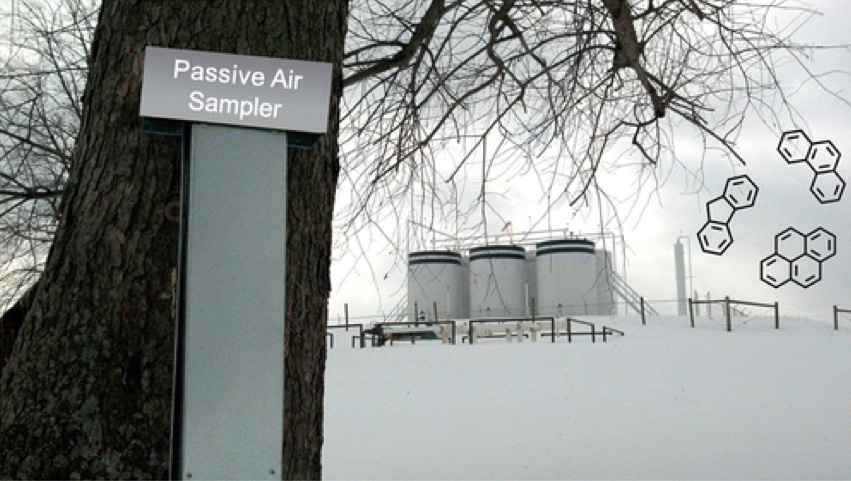 People living or working near active natural gas wells may be exposed to toxic air pollution at higher levels than the Environmental Protection Agency considers safe for lifetime exposure. That's the conclusion of a new study performed by scientists from Oregon State University and the University of Cincinnati, published in the March 26th edition of the journal Environmental Science and Technology.
People living or working near active natural gas wells may be exposed to toxic air pollution at higher levels than the Environmental Protection Agency considers safe for lifetime exposure. That's the conclusion of a new study performed by scientists from Oregon State University and the University of Cincinnati, published in the March 26th edition of the journal Environmental Science and Technology.
Sampling at various sites adjacent or downwind of fracking wells in Carroll County, Ohio over a three-week period last February revolved around 62 Polycyclic Aromatic Hydrocarbons (PAHs), a category of combustion-produced pollutants already linked too everything from childhood obesity to breast cancer, to lower IQ. Carroll County sits on top of the Utica formation, a gas rich shale deposit. The rural county is a hotspot of natural gas drilling and production, with more than one active well site per square mile.
“Air pollution from fracking operations may pose an under-recognized health hazard to people living near them,” said the study’s coauthor Kim Anderson, an environmental chemist with OSU’s College of Agricultural Sciences.
The study was initiated by citizens in the area who wanted to more about the health risks they were facing from fracking. They approached Anderson her peers and and the scientist designed the study to include citizen participation. They placed air samplers on the properties of 23 volunteers living or working at sites ranging from immediately next to a gas well to a little more than three miles away.
Anderson's samplers are aluminum T-shaped boxes containing specially treated polyethylene ribbons that absorb contaminants in a similar manner to biological cells. Volunteers were trained in proper handling of samplers and documenting of data.After the study period, the volunteers packaged the samplers in airtight bags, labeled them and mailed them back to Anderson’s lab at OSU.
Even the lowest levels – detected on sites more than a mile away from a well – were higher than previous researchers had found in downtown Chicago and near a Belgian oil refinery. They were about 10 times higher than in a rural Michigan area with no natural gas wells.
By looking at the ratios of individual PAHs detected by the samplers, Anderson and her team were able to discern whether they came directly from the earth – a “petrogenic” source – or from “pyrogenic” sources like the burning of fossil fuels. The proportion of petrogenic PAHs in the mix was highest nearer the wells and decreased with distance.
The team also accounted for the influences of wood smoke and vehicle exhaust, common sources of airborne pyrogenic PAHs. Wood smoke was consistent across the sampling area, supporting the conclusion that the gas wells were contributing to the higher PAH levels.
The researchers then used a standard calculation to determine the additional cancer risk posed by airborne contaminants over a range of scenarios. For the worst-case scenario (exposure 24 hours a day over 25 years), they found that a person anywhere in the study area would be exposed at a risk level exceeding the threshold of what the EPA deems acceptable.
The highest-risk areas were those nearest the wells, Anderson said. Areas more than a mile away posed about 30 percent less risk.
Estimated worst-case maximum residential exposure was 2.9 in 10 000, which is above the U.S. EPA’s acceptable risk level of one in a million. According to the study's abstract, "This work suggests that natural gas extraction may be contributing significantly to PAHs in air, at levels that are relevant to human health."
Why We Fight: In 1996 and Now
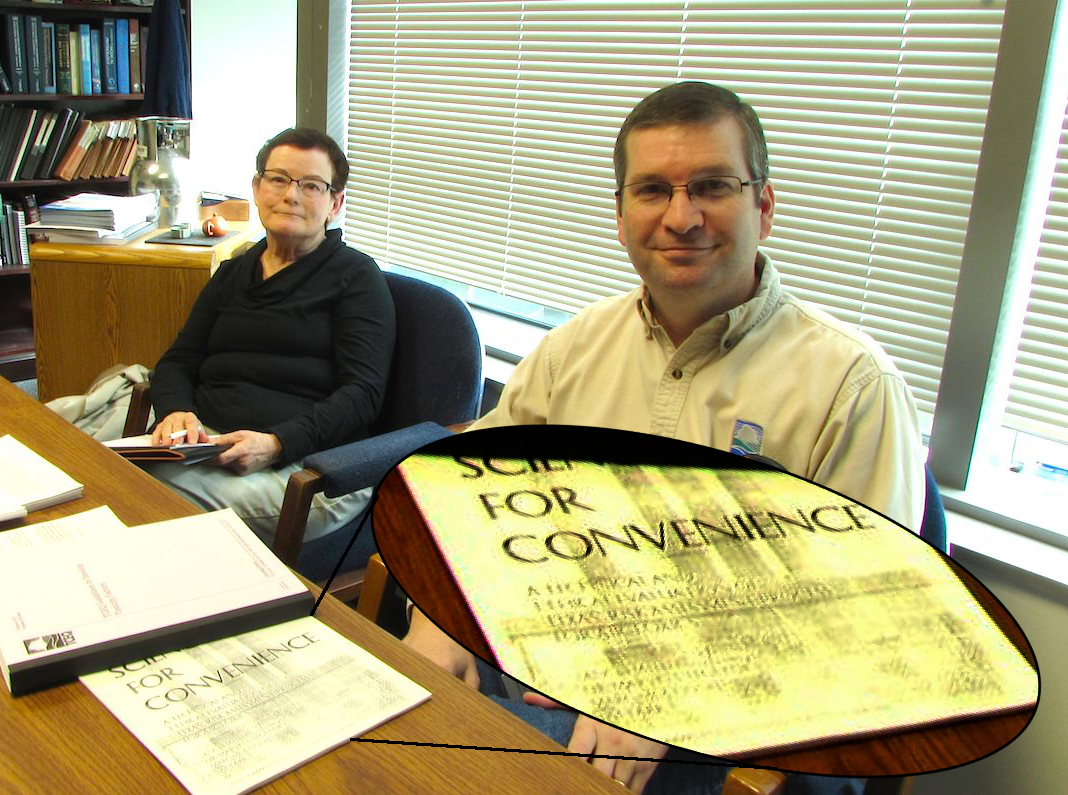 We found a piece of Downwinder's legacy in a very unlikely place this month – on the desk of TCEQ Toxicologist Michael Honeycutt.
We found a piece of Downwinder's legacy in a very unlikely place this month – on the desk of TCEQ Toxicologist Michael Honeycutt.
Right before Christmas, the Washington DC-based Center for Public Integrity published a great examination of how the Texas Commission on Environmental Quality goes out of its way to make sure the poisons citizens are being exposed to in the real world hardly ever reach "levels of regulatory concern." It spotlights Benzene, although you could easily find half a dozen other examples of where the state is moving the toxicological goalposts. This regulatory slight of hand is being directed by Honeycutt, the "smog isn't bad for you" guy that tries to provide the technical fig leaf for the blatant political motives behind the TCEQ's downplaying of pollution harms.
In the middle of the article is a photograph of Honeycutt at his desk with various reports splayed out in front of him. According to the reporter, she asked him to pull out some of the documents that have been influential in getting the TCEQ to re-examine the way it analyzes toxic exposures and human health harms.
And what do you know, right there in front is Downwinders at Risk's own 1996 "Sacrificing Science for Convenience" report – the first-ever critical look at how the state of Texas was officially evaluating toxic exposures, authored by the late great Dr. Marvin Legator of the UT Medical Branch in Galveston and Jim Tarr, a former Texas Air Control Board engineer, who's become an independent consultant, and is in fact quoted in the Center's new article as well.
This report, later turned into a peer-reviewed journal-published article, was a devastating methodical blow-by-blow examination of how the state's "Effects Screening Levels" (ESLs) for pollution were political tools for regulators to allow massive pollution without concern for any adverse human health effects. It led to an embarrassing Houston Chronicle series several years later that forced the state to revamp the ESL system.
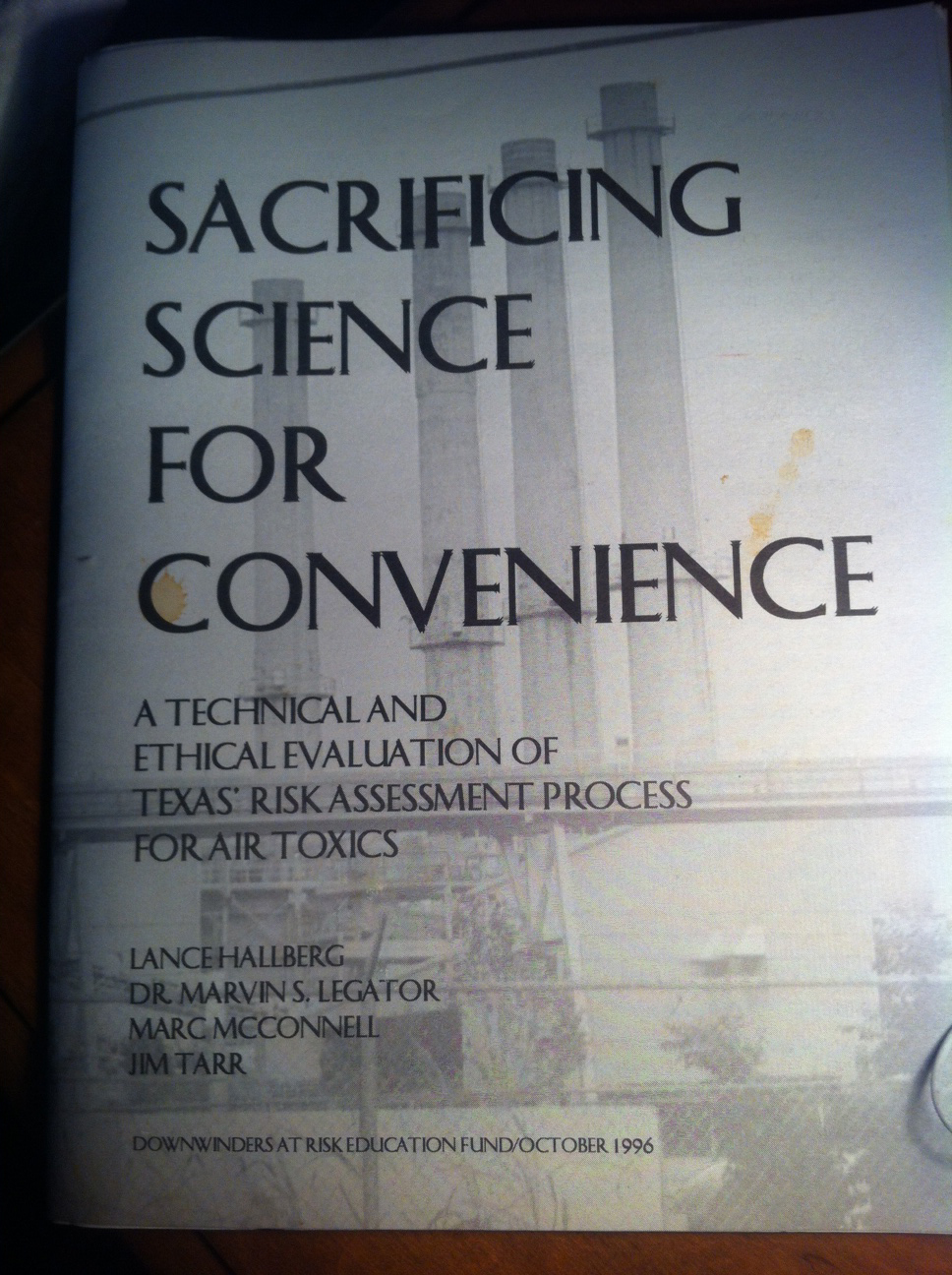 This was the first time anyone had led an scientific inquiry into how the State of Texas regulated toxic exposures. This effort wasn't commissioned by a national or even statewide environmental group, with lots of money and a staff of its own. It was scrapped together by a grassroots group of citizens in DFW.
This was the first time anyone had led an scientific inquiry into how the State of Texas regulated toxic exposures. This effort wasn't commissioned by a national or even statewide environmental group, with lots of money and a staff of its own. It was scrapped together by a grassroots group of citizens in DFW.
At the time, Downwinders' energy was aimed only at fighting the burning of toxic waste in the Midlothian cement plants. Such a report didn't directly serve that cause at all. That's why we're so proud of it. In the middle of the longest, most expensive hazardous waste permit fight in Texas history, we took the time and money to pay for a report that would expose a problem every citizen living near a polluter was facing. We looked at the fundamentals and saw a larger need than just our own self-interests in Midlothian. We took the longer view.
We're still doing that.
We're the only environmental group dealing with fracking as a regional air pollution issue – taking it out of the city-by-city fights we're all accustomed to, and looking at the larger picture of how it adds to North Texas smog.
We're still the only group looking for ways we can disrupt the authority of the state in setting our local environmental agenda. Over the next few weeks you’ll learn how Downwinders is sponsoring the very first effort to give local officials access to the same computer “modeling” the state uses to build its clean air plans. But this computing power is being used to do things the state is refusing to do – like looking at what pollution control measures work best in DFW. It’s the first time anyone has challenged the state’s exclusive ownership of the region’s air computer modeling.
Next month, you’ll see local DFW doctors and nurses testifying on behalf of cleaner air at public hearings on the state’s proposed new smog plan. They’re being organized by Downwinders in an effort to form a North Texas health professionals speakers bureau to put on the front lines of air pollution controversies. Not just our fights – everyone's fights.
Downwinders is doing work no other group is doing – work that benefits everyone who's being shat on by an industrial polluter – whether its a cement plant, a coal plant, or a gas compressor. Because, just like in 1996 when we published "Sacrificing Science for Convenience" we see our job as a larger than our own fights. We understand that we're part of a larger citizens movement. One about the distribution of political power, and the autonomy of an individual to decide for themselves what risks to their health are acceptable.
Next Monday, we'll be sending out an e-mail alert that will be jam-packed with January news about state and national clean air hearings, tributes to our local heroes, and on-going local fights. 2015 is going to be another busy year for us. But we need your help to fund our work today and the next three days. We do what we do on a shoestring budget – usually not more than $30-50,000 a year – but we need new shoestrings. We're completely local, which means we're completely dependent on people like yourself who see the value in our work. If we can't put our organizer in the field, a lot of good things that we want to do next year won't happen. And that'll be a shame not only for our own causes, but for the larger cause as well.
Please click here and give whatever you can.
Anything is truly appreciated – and will contribute to work that has a long shelf life. Thanks.
Make Your Butt A Force for Good Tonight
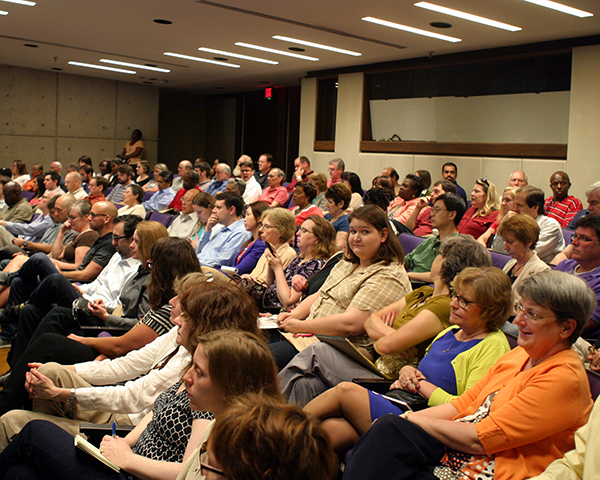 Woody Allen is famously credited with the line that "showing-up is 80% of life." With organizing, it's more like 90%. There are at least two places to be tonight where just your butt in a seat will make a huge, positive difference:
Woody Allen is famously credited with the line that "showing-up is 80% of life." With organizing, it's more like 90%. There are at least two places to be tonight where just your butt in a seat will make a huge, positive difference:
1) Mansfield City Council Work Session on a New Gas Drilling Ordinance, 6 pm, Mansfield Performing Arts Center Workroom, 1110 West Debbie Lane, (near Hwy 287 – just south of I-20) (map).
After almost a year of struggle, residents of Mansfield are getting a hearing tonight in front of their city council. Unfortunately, the council, including two members who make a living from the gas industry, are making the the residents take on the Texas Commission on Environmental Quality, the Texas Railroad Commission, 10-13 gas industry representatives, pro-industry state representatives, senators, and Congressman, as well as their own city staff – all in one evening. They're besieged, and they really need your help tonight.
We have it on good authority that the Mansfield Mayor is using this set-up to "gauge public opinion on the issue" even though members of the public won't get to speak. So it's all about attendance – butts in seats.
Mansfield isn't Dallas. It isn't Denton. It's not even Southlake or Flower Mound. It's deeper into the Shale, more blue collar, and more pro-industry than any other city that's been challenged over their old drilling ordinance in the last several years. The city has more gas wells now per capita – over 200 in a city of 60,000 – than just about any other place in North Texas – with a potential for 300 more. Concerned residents are at a disadvantage in trying to change the status quo.
Just your being there in a seat tonight sends a message you care about this issue. And if you live in Tarrant county or any place else where there's gas drilling in the Metromess, it's in your own self interest to help them in Mansfield. A victory there will make it more possible to win in other places. It will mean less air pollution from their wells and compressors blowing downwind. It will mean the tide is moving further west.
So do yourself, the region, and the cause a favor and show up tonight. You don't even have to speak. You just have to be present to win.
2) Trinity Toll Road Debate – 6:30 p.m. at Rosemont Elementary School, 1919 Stevens Forest Drive (map)
State Representative Rafael Anchia is sponsoring this debate over this leftover 20th Century boondoggle that features almost all the major players on both sides of the issues – Michael Morris, Mary Suhm, Patrick Kennedy and Scott Griggs. Again, your presence sends a valuable signal – that you're opposed to this floodplain toll way, and that this will be an important issue in the May Dallas elections. Go and be active members of the peanut gallery – cheer on the opponents, jeer the supporters.
It's particularly important that the public show increased interest tonight as Suhm and Mayor Rawlings conspire to muddy the waters with a new "review" of the plans of the road. They hope to give Citizen Council-backed candidates in the May election a way out of a simpey yes or no answer to the Toll Road – by saying their waiting for the review. You need to make sure they get the message that nobody is falling for that ruse.
Your butt can be a powerful voice for change tonight, or it can sit on the couch. Get out and show-up.

